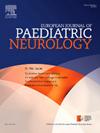Pediatric new-onset super-refractory status epilepticus (NOSRSE): a case-series
IF 2.3
3区 医学
Q3 CLINICAL NEUROLOGY
引用次数: 0
Abstract
Background
New-onset super-refractory status epilepticus (NOSRSE) leads to functional deficits and residual epilepsy. This study aimed to describe pediatric NOSRSE cohort to gain clinical insights of their features.
Methods
A retrospective review of children with NOSRSE in 2013–2024 was conducted at two tertiary hospitals. Patient clinical data, including MRI, CSF profile, EEG, and treatments, were collected and reviewed. The primary outcome measure was the modified Rankin scale score (mRS) at 3-month post-seizure.
Results
Twenty-three patients with NOSRSE, with a median age of 7.9 years, were included. Twenty-one (91 %) had febrile infection-related epilepsy syndrome (FIRES). The initial cerebrospinal fluid (CSF) profile was normal in five (23 %), pleocytosis was present in nine (39 %), and CSF protein was elevated in 15 (68 %) patients. Initial Brain MRI was normal in 14 (61 %) patients. First- and second-line immunotherapy was delivered to 21 (91 %) and 15 (68 %) patients, respectively. The etiology was viral infection in two (9 %) patients, and presumed cryptogenic in the remaining. The primary outcome was poor (mRS ≥4) in 14 (61 %) patients and all had residual epilepsy. Elevated initial CSF protein levels were associated with poor outcomes. Mental status before treatment, time to immunotherapy, intubation of >2 weeks or tracheostomy, and the duration of anesthetics were also associated with the primary outcome.
Conclusion
Most pediatric NOSRSE patients presented as cryptogenic FIRES, with poor long-term outcomes. None of the patients with NOSRSE tested positive for autoimmune antibodies. Many showed permanent MRI changes but did not correlate with outcome. The initial CSF profile may serve as an objective disease severity marker in NOSRSE.
儿童新发超难治性癫痫持续状态(NOSRSE):一个病例系列
背景:新发超难治性癫痫持续状态(NOSRSE)导致功能缺陷和残留癫痫。本研究旨在描述儿童NOSRSE队列,以获得其特征的临床见解。方法对两所三级医院2013-2024年收治的NOSRSE患儿进行回顾性分析。收集并回顾了患者的临床资料,包括MRI、CSF谱、EEG和治疗。主要结局指标为癫痫发作后3个月的改良Rankin量表评分(mRS)。结果入选NOSRSE患者23例,中位年龄7.9岁。21例(91%)有发热性感染相关癫痫综合征(FIRES)。5例(23%)患者脑脊液(CSF)初始形态正常,9例(39%)患者出现多细胞增多,15例(68%)患者脑脊液蛋白升高。14例(61%)患者初始脑MRI正常。一线和二线免疫治疗分别给予21例(91%)和15例(68%)患者。2例(9%)患者的病因为病毒感染,其余患者的病因推定为隐源性。14例(61%)患者的主要预后较差(mRS≥4),且均有残余癫痫。初始脑脊液蛋白水平升高与预后不良相关。治疗前精神状态、免疫治疗时间、插管2周或气管切开时间、麻醉药持续时间也与主要结局相关。结论大多数儿童NOSRSE患者表现为隐源性FIRES,长期预后较差。所有NOSRSE患者自身免疫抗体检测均未呈阳性。许多人表现出永久性的MRI改变,但与结果无关。初始CSF谱可作为NOSRSE的客观疾病严重程度标志。
本文章由计算机程序翻译,如有差异,请以英文原文为准。
求助全文
约1分钟内获得全文
求助全文
来源期刊
CiteScore
6.30
自引率
3.20%
发文量
115
审稿时长
81 days
期刊介绍:
The European Journal of Paediatric Neurology is the Official Journal of the European Paediatric Neurology Society, successor to the long-established European Federation of Child Neurology Societies.
Under the guidance of a prestigious International editorial board, this multi-disciplinary journal publishes exciting clinical and experimental research in this rapidly expanding field. High quality papers written by leading experts encompass all the major diseases including epilepsy, movement disorders, neuromuscular disorders, neurodegenerative disorders and intellectual disability.
Other exciting highlights include articles on brain imaging and neonatal neurology, and the publication of regularly updated tables relating to the main groups of disorders.

 求助内容:
求助内容: 应助结果提醒方式:
应助结果提醒方式:


